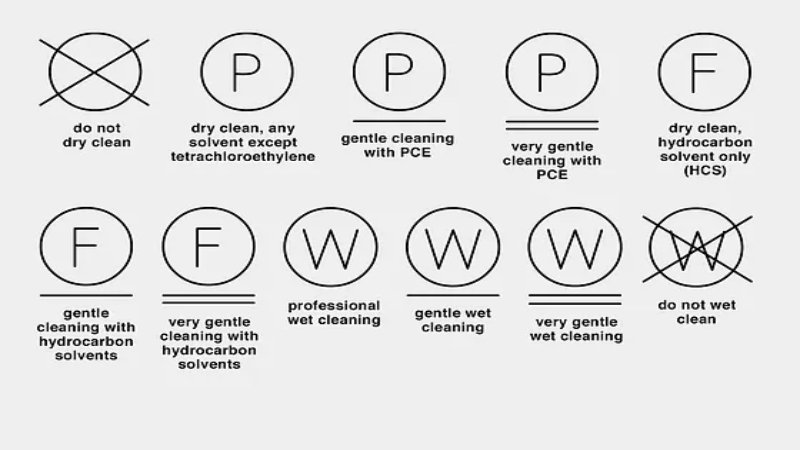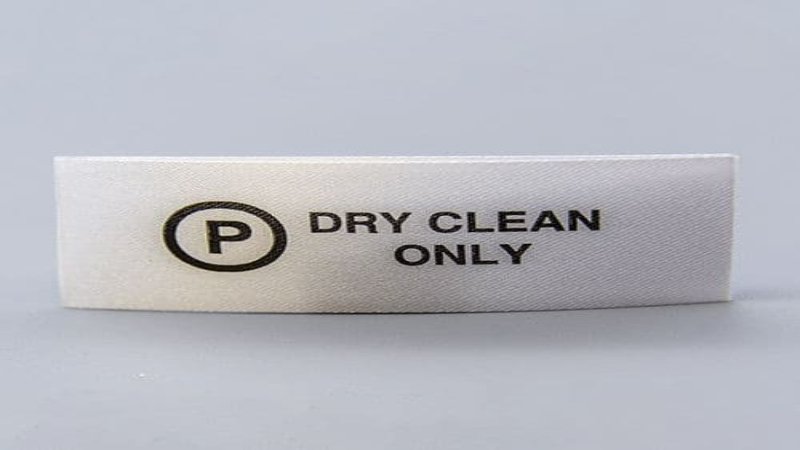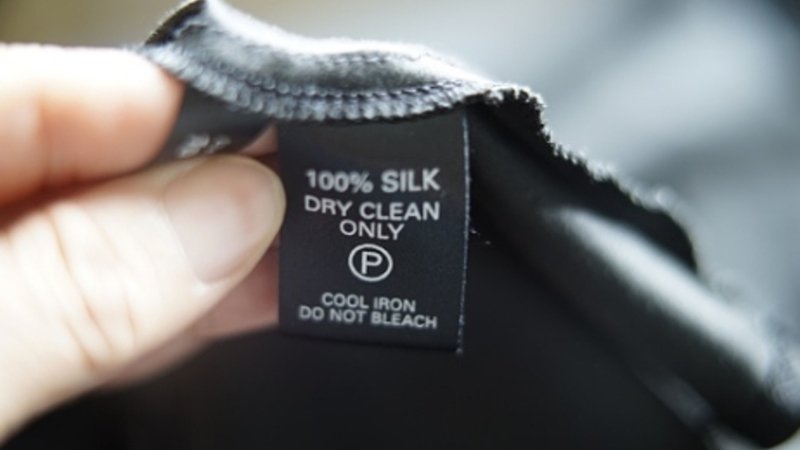Dry Clean Only? Decode the Label and Master Garment Care
Confused by “Dry Clean Only” labels? This guide empowers you to confidently care for your clothes, saving money and preventing damage. Learn when professional dry cleaning is essential and when at-home alternatives are safe. Master garment care, extending the life of your wardrobe and avoiding costly mistakes!
1. Decoding “Dry Clean Only”: Beyond the Label
1.1 What Does “Dry Clean Only” Really Mean?
“Dry Clean Only” on a care label is a mandatory instruction, not a suggestion. It indicates that the garment requires professional cleaning using a waterless, solvent-based process. These solvents, such as perchloroethylene (PCE), clean delicate fabrics without the damaging effects of water.
Contrast this with labels stating “Dry Clean” or “Dry Clean Recommended,” which offer more flexibility. These suggest professional cleaning but don’t strictly prohibit other methods. Think of ‘Dry Clean Only’ as a ‘handle with extreme care’ warning.

1.2 A Quick History of Dry Cleaning: From Accidental Discovery to Modern Garment Care
Dry cleaning emerged in the 1800s, reportedly by accident. Its development revolutionized the textile industry, providing a solution for cleaning delicate fabrics that couldn’t withstand traditional washing methods. This historical context shapes modern garment care.
Understanding the history helps us appreciate why dry cleaning evolved – it was a solution for fabrics that water couldn’t handle. The dry cleaning process has been refined over time but the core principle of using solvents instead of water remains.
2. The Science Behind Dry Cleaning: Why It’s Gentle Yet Effective
2.1 How Dry Cleaning Works: Solvents vs. Water
Dry cleaning is a solvent-based cleaning process. Unlike water, which can swell and damage certain fibers, solvents dissolve oils, grease and other stains without harshness. This makes it ideal for delicate natural and synthetic fibers that are prone to shrinking, stretching or losing their shape.
The dry cleaning process involves immersing garments in a solvent, agitating them gently and then removing the solvent, which carries away the dissolved dirt and stains. This method minimizes stress on the clothing fibers, preventing damage.
2.2 The Benefits Unveiled: Preserving Your Garments’ Beauty
Dry cleaning offers numerous benefits for garment maintenance. It prevents shrinking, distortion and changes in texture or color that can occur with water-based washing. It’s particularly effective at removing oil-based stains, which water often struggles to handle.
Dry cleaning extends the lifespan of your garments and helps maintain their “like-new” condition. It’s the preferred method for structured clothing that could be damaged by traditional washing. Dry cleaning isn’t just about cleaning; it’s about garment preservation.
3. Decoding Fabric Labels: Which Fabrics Are “Dry Clean Only” Culprits?
3.1 The Usual Suspects: Fabrics That Love Dry Cleaning
Certain fabrics are more prone to damage from water-based washing and typically require dry cleaning. These include: Silk, Wool, Acetate, Velvet, Taffeta, Linen. These delicate materials are both natural fibers and synthetic fibers.
These fabrics can shrink, stretch, lose their shape or experience color changes when exposed to water and agitation. Dry cleaning provides a gentler cleaning method that preserves their integrity.
3.2 Beyond Fabrics: Garment Construction Matters Too
It’s not just about the fabric. Consider the garment’s construction. Certain construction features often necessitate dry cleaning, regardless of the primary fabric. These include: Suede and leather items, Structured jackets and blazers. Vintage or specialty items with delicate lace, beading or other embellishments. These elements can be easily damaged by water or agitation. Linings, shoulder pads, intricate details – these often dictate ‘Dry Clean Only’.

4. “Dry Clean” vs. “Dry Clean Only”: When Can You Consider At-Home Care?
4.1 Understanding “Dry Clean Recommended” or “Dry Clean”: Flexibility and Caution
A label stating “Dry Clean Recommended” or simply “Dry Clean” offers more flexibility than “Dry Clean Only.” It suggests professional cleaning as the preferred method but doesn’t strictly prohibit other options. This opens the possibility of gentle at-home methods.
However, proceed with extreme caution. Even with these labels, there’s a risk of damage if not handled correctly. Home laundry should only be considered after careful assessment and testing.
4.2 Fabrics That Might Tolerate Gentle Home Washing (With Extreme Caution!)
Certain fabrics labeled “Dry Clean” (but not “Dry Clean Only”) might tolerate gentle hand washing. These include: Cotton, Linen (sturdy linens, not fine linens), Cashmere (with specific cashmere-washing techniques), Polyester, Acrylic, Nylon. Hand wash delicate fabrics very carefully.
However, emphasize the risks. Shrinking, stretching, color fading and texture changes are still possible. Even with ‘Dry Clean’ labels, proceed with caution when home washing. Always test a hidden area first and if you’re unsure, professional dry cleaning is always the safest bet.
5. The Perils of Ignoring “Dry Clean Only”: Damage Control
5.1 What Could Go Wrong? Shrinkage, Distortion, and Disaster!
Ignoring a “Dry Clean Only” label can lead to irreversible damage to your garments. Potential consequences include:
- Shrinkage: The garment may shrink significantly, becoming unwearable.
- Warping: The fabric can become distorted and lose its original shape.
- Color bleeding: Dyes can run, staining other parts of the garment or other items in the wash. Texture changes: The fabric’s feel can become rough, stiff or otherwise altered.
- Embellishment damage: Beads, sequins or other decorations can be loosened or damaged.
5.2 Fiber-Specific Risks: Viscose, Polyamide, and Leather – Handle with Care!
Different fibers react differently to water, making some particularly vulnerable to damage
- Viscose: This fabric is highly prone to shrinkage and warping when washed.
- Polyamide: This synthetic fiber can expand or warp when exposed to water and heat.
- Leather: “Not Washable” or “Dry Clean Only” leather should never be washed with water. It can become stiff, cracked, and discolored.
6. Pre-Wash Prep: The Spot Test is Your Best Friend
6.1 Colorfastness Check: Don’t Let Colors Run Wild!
The colorfastness test is vital to prevent color bleeding. Dampen a white cotton swab with water and a tiny amount of mild detergent. Gently rub the swab on a hidden seam or inside hem of the garment.
If any color transfers to the swab, the garment is not colorfast and should be professionally dry cleaned. If no color appears, proceed with caution but the risk of bleeding is lower.

6.2 Detailing Inspection: Secure Embellishments and Delicate Trims
Carefully inspect any beading, sequins, lace or other trims. Check for loose attachments and colorfastness. If any details are loose, consider reinforcing them with hand-stitching before washing.
If the embellishments are delicate, extensive or show signs of color bleeding, professional dry cleaning is the safest option. Protecting these details is crucial for maintaining the garment’s appearance. Always perform a spot test, especially for vibrant colors and embellished garments.
7. The Gentle Art of Home Washing “Dry Clean” Items (When Appropriate)
7.1 Hand Washing Heroes: The Safest At-Home Method
Hand washing is the safest at-home method for “Dry Clean” labeled items made from polyester, cotton, linen, cashmere, nylon or acrylic. Fill a clean basin or sink with cold water. Add a small amount of gentle detergent.
Submerge the garment and gently agitate the water. Avoid harsh rubbing or scrubbing. Let it soak for a short time (no more than 30 minutes for most fabrics). Rinse thoroughly with cold water until all detergent is gone. Never wring the garment and gently squeeze out excess water.
7.2 Machine Washing (For the Truly Brave and Durable “Dry Clean” Items)
Machine washing “Dry Clean” items is risky and should only be considered for very durable fabrics like some polyesters and only after successful spot testing. Reserve it for very durable fabrics like polyester and only if you’re comfortable with potential risks. Hand washing is almost always safer.
If you choose to machine wash, follow these specific instructions: Turn the garment inside out. Place it in a mesh laundry bag for added protection. Use a mild detergent. Select the delicate cycle with cold water.
7.3 Drying Dos and Don’ts: Air Drying is Key!
Never use a machine dryer for “Dry Clean” items, even on a low setting. High heat can cause irreversible damage, including shrinkage, warping, and damage to delicate fibers. Air-drying clothes is the best.
For items that can be hung, use a padded hanger to prevent stretching or distortion. For items that might lose their shape, lay them flat on a clean, dry towel. Reshape the garment while it’s damp. Avoid direct sunlight or heat, which can cause fading or damage.

8. When to Trust the Pros: Leave It to the Dry Cleaners
8.1 Stain SOS: Professionals to the Rescue
For stains on any garment labeled “Dry Clean Optional” or “Dry Clean Only,” professional dry cleaning is highly recommended. Dry cleaners have specialized stain removal techniques and solvents that are more effective and safer than home remedies.
Attempting to remove stains at home, especially on delicate fabrics, can often worsen the problem or cause permanent damage. Professional dry cleaners have the expertise to assess the stain and fabric type, choosing the appropriate treatment.
8.2 Material Matters: Always Dry Clean These Fabrics
Certain fabrics must always be professionally dry cleaned, regardless of the specific label wording. These include: Leather and suede, Beaded or sequined items, Silk, Acetate, Velvet, Wool (especially fine wools and structured garments), Taffeta. These materials are highly susceptible to damage from water, heat and agitation. Attempting to wash them at home can result in irreversible shrinking, warping, color loss or damage to embellishments.
8.3 “Dry Clean Only” is Non-Negotiable: Protect Your Investment
“Dry Clean Only” labels should be strictly followed. This is not a suggestion; it’s a directive based on the fabric’s composition and the garment’s construction. Ignoring this label risks ruining the garment, leading to costly replacements. When in doubt, dry clean. It’s an investment in your garment’s longevity and appearance. Think of it as preventative maintenance. The consequences of ignoring care labels can be severe.
9. At-Home Dry Cleaning Kits: A Convenient Alternative?
9.1 How Home Dry Cleaning Kits Work and When to Use Them
Home dry cleaning kits typically involve placing garments in a bag with a cleaning cloth and tumbling them in a dryer. The heat activates the cleaning solution in the cloth, releasing a vapor that helps to refresh the fabric and remove light odors and wrinkles.
These kits are primarily designed for lightly soiled items that need freshening up between professional cleanings. They offer a convenient way to maintain garments at home, saving time and potentially reducing dry cleaning costs for items that don’t require intensive cleaning.
9.2 Limitations and Expectations: Not a Substitute for Professional Cleaning
It’s crucial to understand the limitations of home dry cleaning kits. They are not a substitute for professional dry cleaning for all garments, especially heavily soiled clothes. They may not effectively remove stubborn stains or provide the same crisp, pressed finish.
These kits are best suited for refreshing lightly worn items, removing minor wrinkles and eliminating odors. For heavily soiled garments, delicate fabrics requiring “Dry Clean Only” care or items needing stain removal, professional dry cleaning remains the gold standard. Home dry cleaning kits can be useful for freshening up lightly worn items but they are not a magic bullet.
10. FAQs About Dry Clean Only
10.1 Can I hand wash something that says “Dry Clean Only”?
No. “Dry Clean Only” means do not wash at home, even by hand. Hand washing still exposes the garment to water, which can cause irreversible damage like shrinking, warping or color bleeding.
10.2 What happens if I accidentally wash a “Dry Clean Only” item?
Potential damage includes shrinkage, distortion, color bleeding, texture changes and damage to embellishments. Assess the damage. If significant, consult a professional dry cleaner to see if it can be salvaged.
10.3 Is dry cleaning bad for clothes?
No, when done properly by a reputable professional, dry cleaning is gentle and preserves clothes. Modern dry-cleaning methods and solvents are generally safe for garments and the environment. Some older solvents raised concerns but regulations have improved.
10.4 How often should I dry clean my “Dry Clean Only” clothes?
Only when necessary – when stained, noticeably soiled or after significant wear. Over-cleaning can shorten a garment’s lifespan. For items worn infrequently, airing them out between wears can often suffice.
10.5 Are there eco-friendly dry cleaning options?
Yes. “Green dry cleaning” alternatives use environmentally friendly solvents like liquid carbon dioxide (CO2) or specialized hydrocarbon solvents. Seek out dry cleaners who advertise eco-friendly practices.
11. Packlove – Your Partner in Garment Care and Labeling Solutions
At Packlove, with over 8 years in the garment industry, especially in processing labels and tags for clothes, we understand the importance of clear and accurate care instructions. We’re here to help your business with all your labeling needs. We provide expert guidance. We help you create care labels that comply with regulations and clearly communicate essential information to your customers. Visit Packlove to learn more.
Read more:
This guide has demystified “Dry Clean Only” labels. Remember the importance of strictly following “Dry Clean Only” instructions. Understand the difference between “Dry Clean Only” and “Dry Clean Recommended.” Use extreme caution with any at-home washing. Know when to trust professional dry cleaners.






















